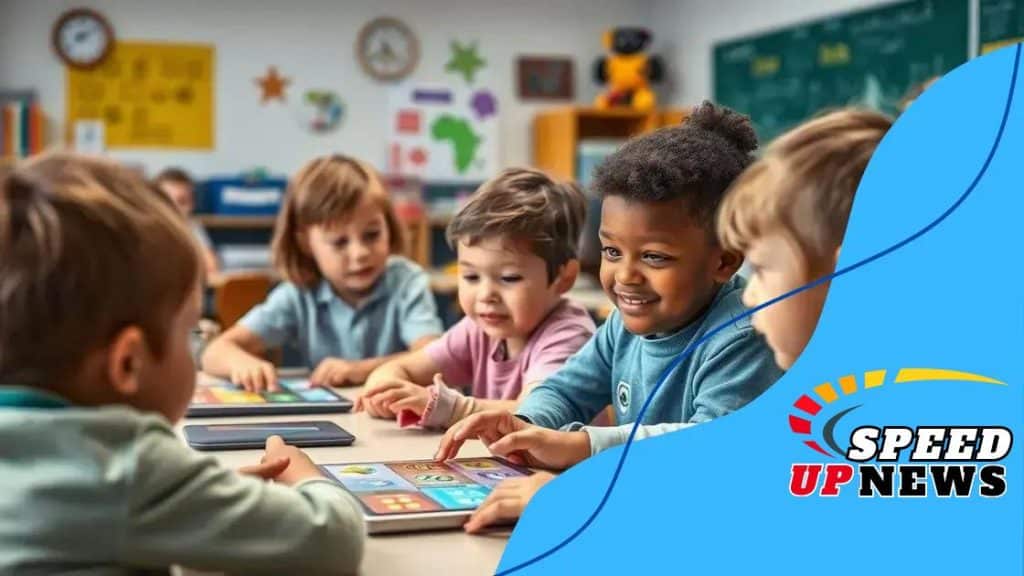Gamified learning tools in elementary education

Gamified learning tools in elementary education enhance student engagement and retention by incorporating game-like elements into lessons, fostering a more interactive and motivating learning environment.
Gamified learning tools in elementary education are transforming how children engage with their studies. Imagine classrooms where learning feels like a game, capturing their attention and boosting motivation. Curious about how this works? Let’s dive into the benefits and applications.
Understanding gamified learning
Understanding gamified learning is essential for creating engaging educational experiences for students. This approach utilizes game elements to motivate learners, making the educational process fun and interactive. By incorporating strategies such as points, badges, and leaderboards, teachers can encourage participation.
What is Gamified Learning?
Gamified learning refers to the application of game design principles in non-game contexts, particularly in education. This strategy enhances motivation and helps students grasp complex concepts. Utilizing challenges and rewards, educators can foster an environment where students are eager to learn.
Key Benefits
- Increased engagement through competition and rewards.
- Enhanced retention of information by associating learning with fun.
- Development of problem-solving skills as students navigate challenges.
- Encouragement of collaboration among peers in team-based tasks.
The essence of gamified learning lies in its ability to make education more relatable and enjoyable. Students are likely to embrace learning when it feels less like a chore and more like a challenge. In classrooms where these methods are utilized, children often demonstrate improved performance and enthusiasm.
Moreover, gamified learning tools can be tailored to fit various subjects and skill levels, allowing for a personalized learning experience. Educators can track student progress and adapt challenges accordingly, ensuring that every learner is effectively supported.
As we dive deeper into the world of gamified learning, it is clear that incorporating these techniques can lead to significant improvements in the educational landscape. By embracing this innovative approach, schools can create a more dynamic and responsive learning environment.
Benefits for elementary students
The benefits for elementary students who engage with gamified learning tools are profound. These tools not only make learning enjoyable, but they also facilitate deeper understanding and retention of knowledge.
Enhanced Engagement
One of the primary advantages of gamified learning is increased engagement. When students participate in game-like activities, their motivation levels rise. This excitement helps them focus better during lessons, making it easier to absorb information.
Improved Retention
- Students remember lessons more effectively when they are presented in a fun, interactive format.
- Challenges and rewards encourage students to revisit concepts.
- Visual and auditory stimuli in games support memory retention.
- Students often recall information better through experiential learning.
Moreover, gamified learning encourages critical thinking. Students must strategize and solve problems, which fosters their analytical skills. They learn to approach challenges creatively, enhancing their cognitive abilities.
Additionally, these tools promote collaboration among peers. Many gamified systems encourage teamwork, allowing students to work together towards common goals. This builds social skills and enhances communication, which are crucial for their development.
Furthermore, gamified learning tools can cater to different learning styles. Visual learners might benefit from colorful graphics, while kinesthetic learners thrive with interactive elements. This versatility ensures that all students have the opportunity to succeed.
As we explore the impact of these tools, it becomes evident that they create a more dynamic and inclusive environment. Elementary students who utilize gamified learning tools are not just learning; they are thriving. By making education enjoyable and engaging, we pave the way for a brighter future.
Types of gamified tools

There are various types of gamified tools that educators can use to enhance student learning in engaging ways. Each tool offers unique features that cater to different aspects of the learning process, providing opportunities for interactive education.
1. Game-Based Learning Platforms
These platforms, such as Kahoot! and Quizizz, allow teachers to create quizzes and games that students can play individually or in teams. These tools make learning fun, as students earn points and rewards for correct answers, promoting a healthy competitive spirit.
2. Digital Badges and Leaderboards
Some tools incorporate digital badges and leaderboards to motivate students. By recognizing achievements, these systems encourage learners to complete tasks and reach milestones. Students can see their progress visually and strive to improve their ranking, which fosters engagement and motivation.
3. Interactive Simulations and Scenarios
- These tools offer real-world problems for students to solve.
- They encourage critical thinking by placing students in challenging scenarios.
- Simulations can cover various subjects, from science experiments to historical events.
- Students learn by experiencing consequences in a safe environment.
Interactive simulations create a strong connection to the subject matter, allowing learners to engage deeply with content. By simulating real-life events, students can apply their knowledge and see how their decisions impact outcomes.
Additionally, story-driven games immerse students in narratives that enhance their understanding. These games often weave educational content into thrilling storylines, encouraging students to progress through levels while learning important concepts.
By utilizing a mix of these tools, educators can create a dynamic learning environment. The right combination can cater to diverse learning styles, making education more accessible and enjoyable for every student.
Integrating tools into the curriculum
Integrating gamified learning tools into the curriculum can transform traditional teaching methods. By thoughtfully including these tools, educators can enhance student engagement and improve educational outcomes.
1. Aligning with Learning Objectives
When incorporating gamified tools, it’s crucial to ensure they align with the learning objectives. Educators should identify key concepts and skills they want students to master. By mapping these goals to the features of various tools, teachers can create relevant and impactful learning experiences.
2. Utilizing a Blended Approach
A blended approach combines traditional teaching methods with gamified elements. For example, teachers can use games for reviewing material before a test or to introduce new topics in a fun way. This method allows for flexibility
- Encourages active participation from students.
- Supports different learning styles through varied content delivery.
- Makes standard assessments more interactive and engaging.
- Increases collaboration among students.
Additionally, teachers can leverage technology to incorporate gamified learning into homework and projects. By assigning game-based tasks, educators can encourage students to explore topics more deeply and creatively. This flexibility supports learners’ diverse interests and strengths.
By integrating gamified tools effectively, teachers can create a more dynamic and inclusive environment. It’s essential to provide adequate training and resources for educators to understand how to use these tools effectively. Collaboration among teachers also ensures that best practices are shared, leading to greater success in the classroom.
Incorporating student feedback can further enhance the integration process. By asking students which tools they found engaging or helpful, educators can adjust their methods to better suit the classroom’s interests.
Measuring effectiveness of gamified learning
Measuring the effectiveness of gamified learning is essential for understanding its impact on student engagement and learning outcomes. Educators can evaluate how these innovative tools influence the classroom experience by implementing various assessment methods.
1. Monitoring Student Engagement
One way to assess effectiveness is by observing student engagement levels. Teachers can take note of students’ participation and enthusiasm during gamified activities. Increased participation often indicates that tools are positively affecting their motivation and interest in learning.
2. Analyzing Assessment Results
Regular assessments are crucial for gauging improvement. Educators should compare test scores before and after introducing gamified tools. This analysis helps in identifying any significant trends in student performance. Additionally, tracking individual progress can provide insights into how different students benefit from these methods.
- Look for improvements in test scores over time.
- Analyze completion rates for assignments related to gamified learning.
- Review feedback from students about their experiences.
- Monitor group dynamics during gamified activities.
Furthermore, qualitative feedback plays a vital role in measuring effectiveness. Surveys and interviews can capture students’ perspectives on how much they enjoy gamified learning. This data can guide adjustments and improvements in the use of tools.
Another important metric is retention of knowledge. By conducting follow-up quizzes or assessments, teachers can determine how well students retain information learned through gamified experiences. If students can recall concepts months later, it suggests successful learning.
Incorporating technology such as analytics tools can also enhance the measurement process. These tools can provide data on how often students engage with gamified content, their completion rates, and their areas of difficulty. This information is invaluable for tailoring future lessons.
FAQ – Frequently Asked Questions about Gamified Learning Tools
What are gamified learning tools?
Gamified learning tools are educational resources that use game-like elements to engage students, making learning more fun and interactive.
How do gamified tools improve student engagement?
These tools increase engagement by providing rewards, challenges, and competition, which motivate students to participate actively in their learning.
Can gamified learning support different learning styles?
Yes, gamified learning tools can cater to various learning styles, helping visual, auditory, and kinesthetic learners engage with content effectively.
How can teachers measure the effectiveness of gamified learning?
Teachers can assess effectiveness through student feedback, engagement levels, and performance on assessments before and after using gamified tools.





